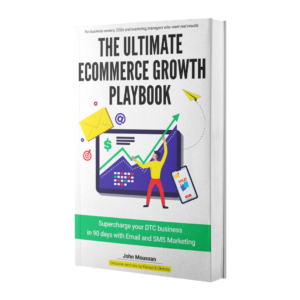
In the direct-to-consumer (DTC) marketing world, there’s a lot of buzz around ‘personalization’, often referred to as the golden key to unlocking unmatched customer engagement and through-the-roof conversion rates. But is personalization truly the be-all and end-all strategy for every DTC brand? With consumers coming across over 5,000 marketing messages every single day, the real challenge lies not just in reaching their inbox or phone screen but in striking the perfect balance between personalization and privacy.
Enter Great White Media, a seasoned sailor of the complex seas of email and SMS marketing in the DTC domain. With a track record of creating bespoke, impactful email marketing strategies, we stand at the forefront of redefining personalization in the industry.
In this article, we explore the nuanced reality of email personalization in DTC marketing, challenging the reigning notion that personalized emails are always better. We discuss the delicate interplay between personalized messaging and consumer perception, shining a spotlight on the instances where personalization can actually be a double-edged sword, leading to potential decision fatigue or privacy concerns. Conversely, we also celebrate the successes, highlighting when and how personalization in email marketing truly enhances the customer journey.
Debunking the personalization myth
Personalization in DTC e-commerce is celebrated for promoting customer engagement and conversions, but despite the enthusiasm, the actual impact of personalization on consumer behavior is more delicate than the industry hype leads us to believe. A Direct Marketing Association study highlights an increase in click-through rates and sales with personalized emails, yet the broader narrative reveals consumer resistance to excessive personalization.
Shoppers can feel overwhelmed or perceive highly customized approaches as intrusive, challenging the notion that more personalized emails are inherently better. This discrepancy highlights the importance of a balanced email marketing strategy, where personalization enhances rather than detracts from the customer experience.

The pitfalls of over-personalized email marketing
The drive towards hyper-personalized emails frequently disregards the intricate layers of consumer behavior, leading to unintended consequences. The marketing industry’s devotion to tailoring content to the nth degree sometimes misses the mark by not accounting for varied consumer opinions and the psychological impact of over-customization, which we explore below:
- Decision paralysis: Consumers faced with too many personalized options can struggle to come to a purchase decision. A study by the Journal of Consumer Psychology found that while a moderate level of personalization can aid decision-making, excessive personalization can overwhelm consumers, decreasing overall satisfaction and, therefore, the likelihood of purchase.
- Privacy concerns: The ruthless pursuit of customer data for hyper-personalization raises red flags for many consumers. According to a Pew Research Center survey, 62% of consumers are more concerned about the privacy of their personal information now than they were five years ago. This heightened awareness can translate into skepticism and distrust towards brands that appear to “know too much”.
The true value of personalized messaging
While indiscriminate email marketing personalization efforts can lead to downfalls, such as decision paralysis and privacy concerns, it’s vital to differentiate these from the transformational power of email personalization that’s executed with precision and restraint.
Here, we explore the major advantages of personalization along with the scenarios in which it proves most beneficial:
Creates engaging customer experiences
Modifying the customer journey with personalized content can transform basic interactions into interesting, gratifying experiences. The right level of attentiveness to an individual’s desires and behaviors not only boosts their level of satisfaction but can also encourage loyalty and retention.
Boosts content relevance and engagement
Personalization can maximize content relevance, substantially increasing engagement rates. For instance, data shows that emails featuring personalized subject lines are opened 26% more than those without, highlighting the significant effect of tailoring content to individual recipients.
Increases conversion rates
By focusing on individual consumer needs and interests through personalization, e-commerce businesses can significantly improve their conversion rates. Epsilon’s research supports this, showing tactfully personalized emails achieve six times the transaction rates of their generic counterparts.
Enhances segmentation and targeting
Using customer data for audience segmentation supports more specific and impactful email marketing campaigns. This strategy not only optimizes marketing resources but also ensures that messages reach the most engaged audience segments, which can enhance the overall effectiveness of email campaigns.
Fosters long-term relationships
Personalized email communication, when done right, helps to develop and maintain strong customer relationships. Delivering resonant, dynamic content nurtures brand loyalty and encourages ongoing engagement, laying the foundation for a strong customer base.

Achieving the personalization balance
We get that you’re now probably thinking, “Well, great, do I personalize or not?” Don’t worry, we’ve got your back. Below, you can find some steps and practical advice to master your personalization techniques:
1. Use data wisely
Use consumer data to advise your email personalization efforts without overstepping boundaries. This refers to analyzing behavior and preferences to create messages that are both relevant and welcome.
Pro Tip: Implement machine learning algorithms to anticipate consumer preferences based on their interaction history.
2. Opt for segment-based personalization
Instead of hyper-personalizing for individuals, think about segmenting your audience based on shared qualities or behaviors. Doing this allows for email personalization that feels individualized without being invasive.
Pro Tip: Use analytics tools to segment your audience into groups with similar interests or behaviors and customize your messaging to each segment’s preferences and needs.
3. Prioritize consent and privacy
It’s important that your personalization strategies always comply with data protection regulations and that you obtain consumer consent. Transparency surrounding data use builds trust and respect.
Pro Tip: Implement an easily accessible privacy policy and consent procedure on your website, clearly explaining how your business intends to use consumer data for personalization.
5. Test and learn
Regularly test different levels of personalization in your email campaigns to establish what resonates best with your audience. A/B testing can be a great way to gauge the effectiveness of personalized vs. generalized messages.
Pro Tip: Run A/B tests on email subject lines, content personalization, and call-to-action variations to determine the most effective approaches for engaging your target segments.
Final thoughts
As we’ve explored, personalization has its pitfalls, but, when applied judiciously, its advantages simply can’t be ignored!
The cherry on top? You don’t have to dabble in finding the right balance alone. At Great White Media, we stand ready to do the heavy lifting for you, ensuring your email and SMS marketing efforts are both effective and respectful. By focusing on strategic personalization, at an expert level, we can help you build deeper connections with your audience and boost your success. Let’s start a conversation today. Reach out to us for a COMPLIMENTARY discovery call.







